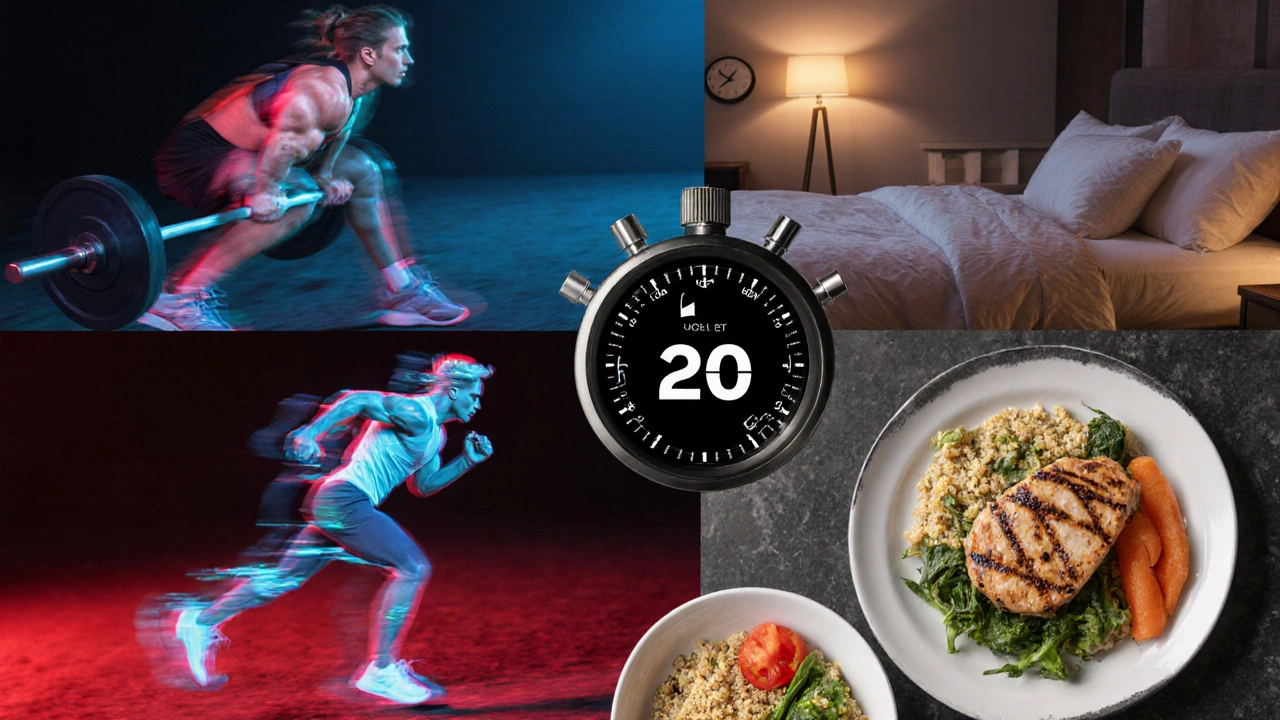
When people ask for the fastest way to get in shape, they usually mean a blend of lower body fat, higher muscle tone, and better endurance-all achieved in a short timeframe. Getting in shape is a holistic state where cardiovascular fitness, muscular strength, flexibility, and body composition improve together. It isn’t a magic shortcut; it’s the result of four core pillars working in sync: intense cardio, resistance work, nutrition, and recovery. Below we break each pillar down to the nitty‑gritty so you can start seeing change in weeks, not months.
Think of the fastest transformation as a three‑legged stool. If one leg is weak, the whole thing wobbles. The following pillars are the legs you need to strengthen:
We’ll dive into each pillar, then stitch them together into a 4‑week fast‑track plan.
HIIT is the single most efficient cardio method for fat loss. A typical session looks like this:
Science from the 2023 Journal of Sports Medicine shows that 15 minutes of HIIT three times a week can improve VO₂ max by 12% and increase resting metabolic rate by 5%.
When you’re just starting, keep the work interval at 20 seconds and the rest at 40 seconds. As fitness improves, push the work to 30 seconds and shorten rest to 30 seconds for a higher intensity ratio.

Muscle is metabolic tissue-more muscle means more calories burned even while you’re binge‑watching Netflix. Focus on compound lifts that engage multiple joints:
Apply the principle of progressive overload gradually increasing resistance or volume. A simple way is the “2‑plus‑1” rule: add 2kg to the bar each session when you can complete all sets with proper form, and add an extra rep once you hit the target weight.
Training frequency matters. For rapid gains, hit each major muscle group twice per week. A sample split:
Stick to 3-4 sets of 6-10 reps for strength, and 12-15 reps for hypertrophy. The blend ensures both neural adaptations (strength) and muscle size (mass).
Even the best workouts crumble without proper fuel. Here are three evidence‑based nutrition rules:
Sample day:
| Meal | Protein (g) | Carbs (g) | Fat (g) | Calories |
|---|---|---|---|---|
| Breakfast (pre‑workout) | 30 | 40 | 10 | 350 |
| Post‑workout shake | 25 | 45 | 5 | 300 |
| Lunch | 35 | 30 | 15 | 450 |
| Dinner | 35 | 30 | 20 | 550 |
| Snacks | 20 | 20 | 10 | 300 |
Adjust portions based on personal preference, but keep protein high and carbs strategic.
Recovery is often the missing link in fast‑track programs. During deep sleep, growth hormone spikes, aiding muscle repair and fat mobilisation. Studies from the 2022 Sleep Research Society indicate that sleeping less than 6 hours can blunt insulin sensitivity by up to 30%, making fat loss harder.
Practical tips:
Combine sleep with active recovery modalities like foam rolling, mobility drills, or light yoga (Yoga gentle stretching practice to improve flexibility and circulation) to keep joints healthy.
Below is a sample schedule that blends the pillars. Feel free to swap exercises based on equipment, but keep the structure intact.
| Day | Focus | Key Activities |
|---|---|---|
| Monday | HIIT + Upper Push | 4×30‑sec sprints (60‑sec rest), Bench Press 4×6‑8, Overhead Press 3×8‑10 |
| Tuesday | Lower Strength | Back Squat 5×5, Romanian Deadlift 4×8, Core Circuit (plank, side‑plank) |
| Wednesday | Active Recovery | 30‑min yoga flow, Light mobility work |
| Thursday | HIIT + Upper Pull | Burpee‑to‑Pull‑up intervals 6×20‑sec, Bent‑over Row 4×6‑8, Face Pulls 3×12‑15 |
| Friday | Lower + Core | Front Squat 4×6, Lunges 3×12each leg, Hanging Leg Raises 3×15 |
| Saturday | Optional Cardio | 30‑min steady‑state jog or bike at 65% HRmax |
| Sunday | Rest | Full day off, focus on sleep hygiene |
Track two metrics each week: body weight (or body fat %) and the amount of weight lifted on your core lifts. Aim for a 2-5% weight increase per lift every week; if you miss, reassess rest or nutrition.
Even the best plan can stall if you fall into these traps:
Address each by setting weekly check‑ins, using a simple journal or a fitness app to log workouts, meals, and sleep hours.
Yes, most people notice improved stamina, a tighter midsection, and modest weight loss within 10‑14 days, especially if they were previously sedentary.
A gym helps with heavy barbell work, but you can replicate the plan at home with dumbbells, a kettlebell, and a sturdy chair for dips. The key is to keep the intensity high.
Aim for the same 1.6-2.2g per kg, but source it from beans, lentils, tempeh, Greek yogurt, and protein powders made from pea or rice.
Daily HIIT can lead to burnout and injury. Limit high‑intensity days to three or four per week and fill the rest with low‑impact activities like walking or yoga.
Pick a time you can consistently stick to. Morning sessions boost metabolism for the day, while evening workouts may feel stronger after you’ve eaten.